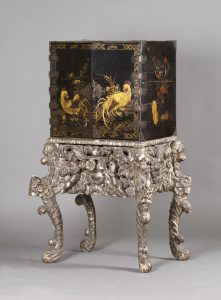
In the late 17th century and first half of the 18th century lacquer cabinets were highly prized by English collectors who were captivated by their flawless finish and exotic decoration. Such cabinets commanded very high prices and they remained beyond the reach of all but the wealthiest.
The lacquered furniture which remains in English collections today include Oriental examples like the early/mid-18th century cabinet you see here.
The two door cabinet enclosing small drawers was easily accommodated in European collections. The clarity of line and decoration would have a profound effect on English cabinet making.
In China and Japan these cupboards stood on or near the floor. However, in Europe they were raised on elaborately carved stands to create centrepieces for important rooms.
Unlike the Dutch the English did not trade directly with Japan at this date. It was traditionally thought that Japanese Lacquer was imported to England from Holland. But given the British East India Company’s monopoly to import Oriental goods to England this seems unlikely. More probable is that Japanese lacquer pieces were bought by the British East India Company at Dutch trading stations like Batvia which is now part of Indonesia.
The principle component of Oriental lacquer is the sap of the Laq tree, Rhus verniciflua, which hardens to form a transparent coating. The lacquer was applied in thin coats with each layer being allowed to harden before the next was applied. Coloured pigment, powdered metals, clay and sawdust were added to create colour and the decorative motifs.
18th century collectors, antiquaries and travellers brought together, but also sought to classify, objects from the world around them. Many of these objects were categorised according to the seven major new areas of enquiry during the Enlightenment. These included: natural history, art and civilisation, religion and ritual, the birth of archaeology, discovery and trade, the translation of ancient scripts and classification. It was objects like these which might have once been curated in this cabinet.
The cabinet illustrated is an example of Japanese lacquer and is decorated with exotic birds and flowers.
The stand is most likely English. It is the right period for the cabinet and fits it perfectly which gives a good indication that it was probably made for it. The stand is profusely decorated in the Baroque taste, elaborately carved with cherubs and flower and leaf swags supported by naturalistic cabriole legs.
It will be auctioned at Toovey’s next fine furniture sale on Friday 24th May 2019
Japanese lacquer cabinets with English baroque stands continue to fascinate wealthy English collectors in the 21st century as they did in the 18th.
By Rupert Toovey, a senior director of Toovey’s, the leading fine art auction house in West Sussex, based on the A24 at Washington. Originally published in the West Sussex Gazette.